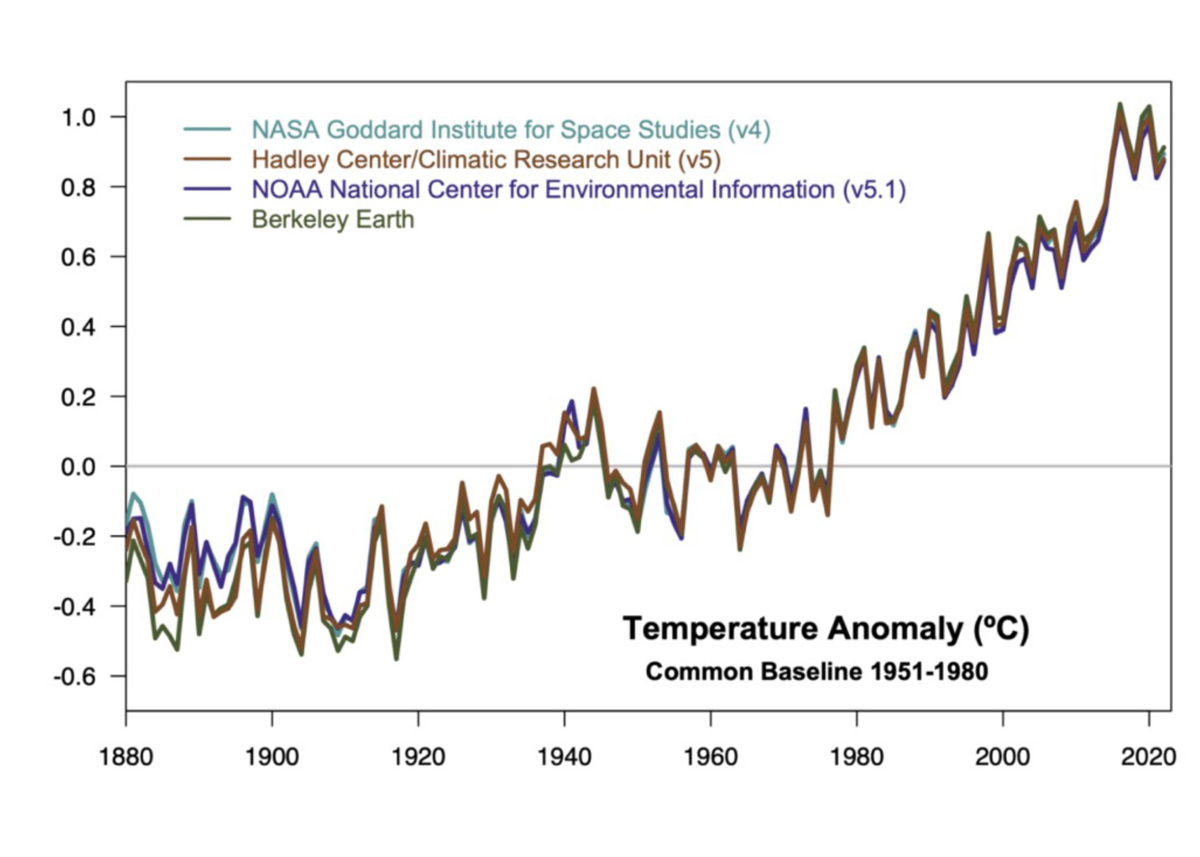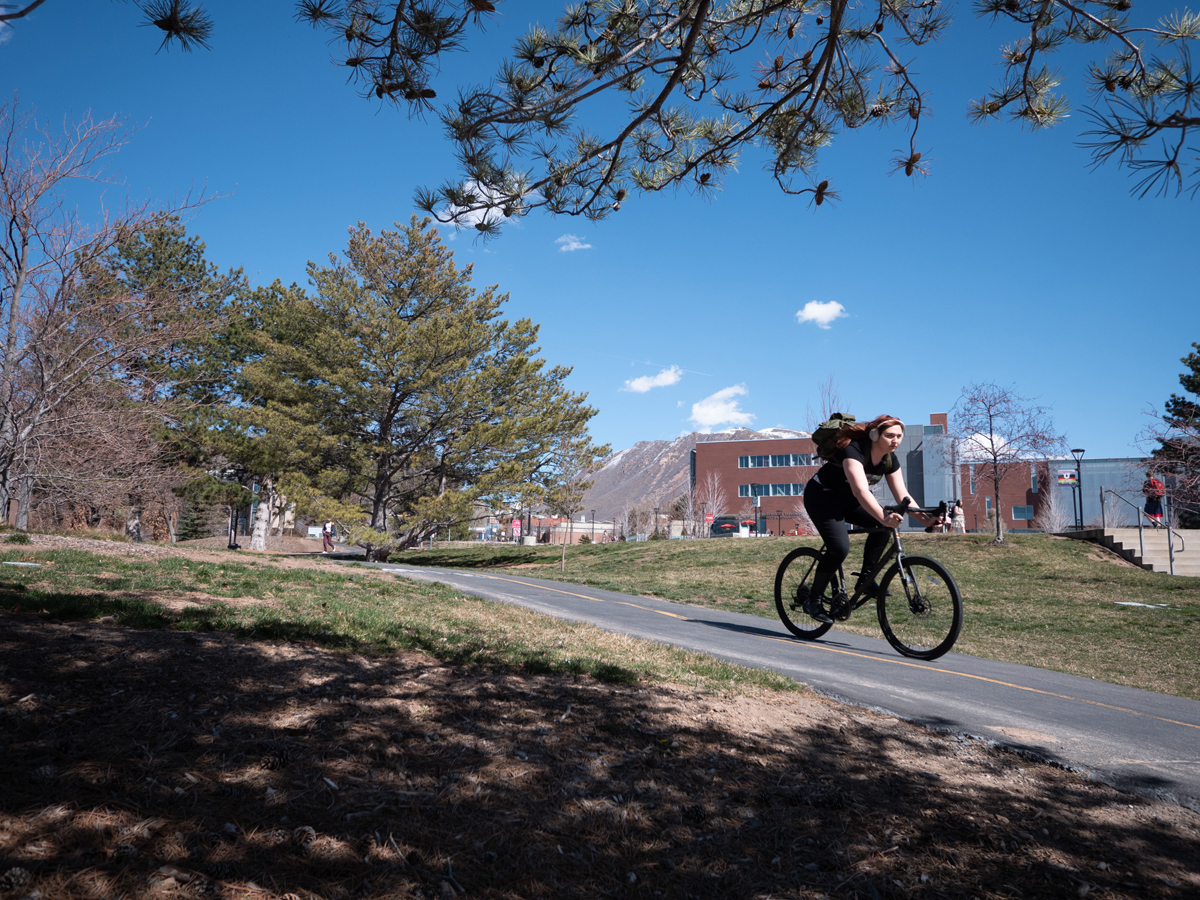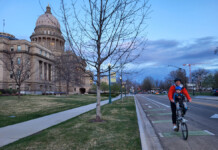By Savannah Cottam — As we combat the intersecting crises of declining societal health and the degradation of Earth, a stark reality unfolds – those born after 1980 have never experienced a below-average global year or month in temperature (1). This underscores a shift in our climate. While Earth’s orbital changes might suggest gradual cooling, this has not been the case. Humans have caused 90-100% of global warming (2). This graph shows the temperature rise from 1880-2020 (3).

The deviation from expected patterns comes with severe consequences, impacting weather systems, triggering mass extinctions, and jeopardizing the well-being of communities worldwide. When confronted with this urgent dilemma, a potential solution emerges: cycling. Beyond being a mere mode of transportation, cycling embodies an integrated approach to mitigating both environmental and societal challenges. Here, we explore how the simplicity of cycling can pave the way for a healthier planet and healthier communities.
Climate Myths
There are myths that many encounter when grappling with climate change. We can combat myths using science. “Climate has changed before, therefore humans aren’t responsible for climate change”. There is a portion of this statement that is true: yes, climate has changed before, however the rate of change is critical. Today’s climate change is 10-100 times faster than any previous changes in the past 50-60 million years. Other myths versus what scientists are saying are shown in the table below (4):
| Client Myth | What the Science Says |
| “Climate’s changed before” | Climate reacts to whatever forces it to change at the time; humans are now the dominant force. |
| “It’s the sun” | In the last 35 years of global warming, the sun and climate have been going in opposite directions. |
| “It’s not bad” | Negative impacts on global warming on agriculture health and environment far outweigh any positives |
| “There is no consensus” | 97% of climate experts agree humans are causing global warming |
| “It’s cooling” | The 10 hottest years on record have occurred since 2010. |
Cycling’s benefits toward Climate Change
In 2021, the Intergovernmental Panel on Climate Change identified bicycling as a solution to ensure a sustainable world for everyone, both now and in the future. “Targets to reduce carbon emissions by 2030 in line with the 1.5-degree limit for global warming cannot be achieved without a systematic increase of cycling” (5). That one small decision you make to get on a bike versus in your car for a short distance errand has impacts on the air and noise pollution, the common good, as well as your own physical and mental health.

According to research, a standard vehicle releases around five metric tons of carbon dioxide a year. Choosing a bike instead of a car just once a day cuts an average person’s transportation-related carbon emissions by 67% (6). Cycling has a carbon footprint that is up to 30 times lower than a fossil fuel car. Surprisingly, cycling’s carbon footprint is less than walking or taking public transportation. Studies indicate, the significance of cycling in helping cities achieve net zero emissions could be 10 times greater than electric cars (6). In addition, noise generated by cars contributes to noise pollution. This has negative environmental impacts, disrupting ecosystems and leading to health issues for people (7).
Cycling and the Common Good
From a community standpoint, cycling rather than driving is associated with participatory activities, helpfulness, and solidarity in the neighborhood thus positively impacting the orientation toward the common good. Cars reduce an individual’s direct contact with their environment. The direct experience that cycling has to the neighborhood environment leads to a stronger emotional bond within society. This emotional attachment of people to their neighborhood is considered a mediator for civic activities (8). Cycling gives rise to connectivity and orientation toward the common good (5).
Cycling and Well Being
From an individual’s perspective, cycling not only enhances brain functions like memory and creative thinking but also significantly contributes to cardiovascular health. The cardiovascular benefits of cycling include improved heart health, increased blood circulation, and reduced risk of cardiovascular diseases. Moreover, the endorphin release during cycling acts as a natural mood booster, further highlighting its positive impact on mental health. By reducing stress hormones like adrenaline and cortisol, cycling not only promotes relaxation but also contributes to better sleep quality. In essence, cycling becomes a holistic approach to well-being, combining physical fitness with improving mental health (7).
Cycling will Save you Money
Cycling will save you money, “If you ride just 10 miles each week on average over the course of a year, you’ll save $299” (9). This could mean biking to various destinations such as grocery stores, events, meetings, or social gatherings just once a week. Moreover, if you increase your biking distance to 20 or 40 miles per week for commuting to work or school, your savings will substantially increase as you establish this habit. Choosing a bike over a car can eliminate the majority of expenses associated with driving. Once you’ve invested in your bike and any necessary equipment, your ongoing expenses are close to zero.
How have Countries Implemented Cycling into Society?
European communities have turned cycling into a transportation norm. In Denmark, 90 percent of the population own a bike while only 56 percent own a car. In Amsterdam, there are 800,000 bikes and only 263,000 cars. With a population of 779,808, that amounts to more bikes than people (10,11,12).
Why is cycling so prevalent in these places and how can we implement these ideas in the U.S.? Culture and infrastructure have proven to play a huge role in the norm and feasibility of cycling.
In America there is a certain brand or stigma around cycling. The feeling of not fitting in or being out of one’s comfort zone causes people that don’t fit the brand to veer away from cycling. In Denmark and the Netherlands all demographics bike, “The bike is an integral part of everyday life rather than a specialist’s accessory or a symbol of a minority lifestyle, so Dutch people don’t concern themselves with having the very latest model of bike or hi-tech gadgets.” Riding attire takes a similar ‘function over fashion’ aesthetic.” (13).
Time is at the top of many people’s priority list. To instigate a new form of transportation you must make it quick and convenient. According to Hanscom, Denmark has spaces dedicated to stacks of bikes parked in the hundreds instead of expansive parking lots. Additionally, bike lanes are visibly marked and undergo regular maintenance and ‘bicycle superhighways’ connect nearby suburbs to main city centers. Successful initiatives typically include: bike education programs, bike lanes, boulevards and off-street pathways, bike-sharing programs, cost-sharing programs, parking infrastructure, transit integration, and well-connected bike networks. (10,11,12). These changes range from small to big initiatives.
As an individual voting for those promoting better infrastructure or joining a cycling advocacy program will cause a ripple effect toward significant change.
Conclusion
As we navigate a climate crisis, the simple act of cycling emerges as a potent solution. Beyond reducing emissions and noise pollution, it fosters community bonds. By drawing inspiration from European models, we can redefine cycling in the U.S., making it inclusive and convenient for all.
Why not embrace the pedal-powered change? The time is now to make cycling accessible, not only for personal well-being but for the health of our planet. The revolution begins with each turn of the wheel, and the time to ride towards a sustainable tomorrow is now.
References
- Schmidt, NASA GISS/Gavin. “Yearly Temperature Anomalies from 1880 to 2019.” https://www.nasa.gov/news-release/nasa-noaa-analyses-reveal-2019-second-warmest-year-on-record/
- John Cook et al 2016 Environ. Res. Lett. “Consensus on consensus: a synthesis of consensus estimates on human-caused global warming”. IOP Science. 13 April 2016, https://iopscience.iop.org/article/10.1088/1748-9326/11/4/048002
- Why Does the Temperature Record Shown on Your ‘Vital Signs’ Page Begin in 1880? – Climate Change: Vital Signs of the Planet.” NASA, NASA, 2020, Climate.NASA.gov
- Stanford University. “Climate change occurring ten times faster than at any time in past 65 million years” ScienceDaily, ScienceDaily, 1 Aug. 2013, https://www.sciencedaily.com/releases/2013/08/130801142420.htm
- Schuster, H., Van der Noll., & Rohmann, A. (2023). “Orientation towards the Common Good in Cities: The Role of Individual Urban Mobility Behavior.” Journal of Environmental Psychology, Academic Press, 2 Sept 2023, http://www.sciencedirect.com/science/article/pii/S0272494423001731
- Christian Brand a b, et al.“The climate change mitigation effects of daily active travel in cities” Transportation Research Part D: Transport and Environment, Pergamon, 27 Feb. 2021, www.sciencedirect.com/science/article/pii/S1361920921000687
- Hallisey, Karen. “How Riding a Bike Benefits the Environment ” Transportation, 20 Oct. 2023, https://transportation.ucla.edu/blog/how-bike-riding-benefits-environment
- Stefaniak, A., Bilewicz, M., & Lewicka, M. (2017). The merits of teaching local history: Increased place attachment enhances civic engagement and social trust. Journal of Environmental Psychology, 51, 217–225. https://doi.org/10.1016/j.Jenvp.2017.03.014
- Kinzer, Dave. “Money on the brain: Use your bicycle for transportation to save money” The State Journal Register. 25 August. 2020. https://www.sj-r.com/story/business/columns/2020/08/25/money-on-brain-use-your-bicycle-for-transportation-to-save-money/114360262/
- Hanscom, Greg. “An American in Denmark: Close encounters with European bicycle culture.” Grist. August 5, 2013 https://grist.org/cities/an-american-in-denmark-close-encounters-with-european-bicycle-culture/
- Hanscom, Greg. “Spin cycle: Copenhagen’s rise, fall, and rise again to cycling supremacy.” Grist. August 7, 2013, https://grist.org/cities/spin-cycle-copenhagens-rise-fall-and-rise-again-to-cycling-supremacy/
- Hanscom, Greg. “Riding lessons for U.S. cities from one of Europe’s bike capitals.” Grist. August 9, 2013, https://grist.org/cities/riding-lessons-what-u-s-cities-can-learn-from-one-of-europes-bike-capitals
- BBC Magazine. “Why is cycling so popular in the Netherlands”, BBC.com August 8, 2013, https://www.bbc.com/news/magazine-23587916








